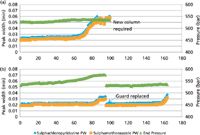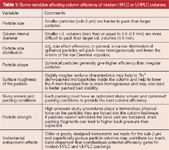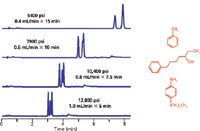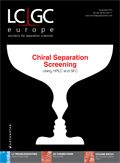The Top 10 HPLC and UHPLC Column Myths: Part 2
LCGC Europe
In the final part, the top 10 HPLC and UHPLC column myths are presented and attempts are made to demystify them by offering some evidence that they are untrue. This part will feature myths five to one.
In the second of a two-part feature from Ron Majors, the top 10 high performance liquid chromatography (HPLC) column myths are presented and attempts are made to demystify them by offering some evidence that they are untrue. This part will feature myths five to one. Since ultrahigh-pressure liquid chromatography (UHPLC) has come about, new myths are popping up and these shall also be dealt with here.
In any field there are often "misconceptions" or "myths" that are perpetuated and passed on to the next generation. These myths are often driven by a lack of understanding by practitioners of the real issues, and can change as time moves on. The purpose of this instalment of "Column Watch" is to revisit and update readers on the most popular high performance liquid chromatography (HPLC) and ultrahigh-pressure liquid chromatography (UHPLC) column myths of today and try to dispel some of these myths before they get perpetuated. This column is an adaptation of an oral presentation at the HPLC2013 conference in Amsterdam, the Netherlands (1). In keeping with the "countdown theme," I will continue with number five and work my way up to the top myth.
Myth 5: UHPLC Packed Columns Plug More Easily Than Conventional HPLC Packed Columns
False: The continual downward movement in particle sizes for porous particles has led to some major column hardware designs. The truth is that the actual bed isn't the culprit for these pressure buildups, but more often than not it is the frit design. Many column pressure problems associated with the sub-2-μm UHPLC columns are a result of sample and mobile-phase matter lodging on the inlet frit. Why are the frits the possible problem? One must consider the particle size distribution of a typical porous particle. When a user buys a 1.8-μm column all of the particles packed inside of that column are not 1.8 μm; there is a particle size distribution (Δdp). There may be some 1.4–1.6 μm particles on the low end and 2.0–2.2 μm particles on the high end of this distribution. The manufacturer has to make sure when they pack the column that the bottom frit porosity is smaller than the smallest particle that may be in the packing particle size distribution. If not, there is the possibility that the smallest packing particles can pass through the frit or even lodge in the porous frit and cause problems later. One must also remember that the frit has its own pore distribution so manufacturers choose a frit porosity much lower, generally in the 0.3–0.5-μm region. For 3.5- and 5.0-μm columns, a 2-μm porosity frit is sufficient to hold the particles during the packing process because the smallest portion of the Δdp rarely approaches 2-μm in size. Very seldom do users complain about plugging frits on a 3.5- or a 5-μm column, unless they do something silly like injecting raw sample that may have lots of particulates.
For the sub-2-μm columns, if they are to be used for column switching or backflushed for particulate removal, the manufacturer must also install a frit on the top of equivalent porosity to the bottom frit (0.3–0.5 μm). So, if the user injects unfiltered plasma or river water samples onto this UHPLC column, there is a very good chance that the column may plug after several repeated injections. In that case, a user may try to recover the expensive column by reversing the column and attempting to flush out the particulates (see Myth 3). So the plugging problem with the UHPLC column is often not the packed bed being damaged, it is the frit being blocked.
What can be done to protect the inlet column against blockage? There are several in-line devices that can keep particulates (and even chemical contaminants which can also cause a blockage in the packed bed) out of the LC system. First, an in-line, zero-dead-volume filter can be placed between the injector and the column. These devices have replaceable 0.2–0.45 μm frits that will trap any particulates that find their way into the sample or the mobile phase. After the in-line filter becomes plugged (by evidence of rising pressure), the unit can be disassembled, the filter replaced, and the LC system is up and running in a few minutes. Most modern in-line filters are of very low dead volume so they shouldn't provide any extracolumn band broadening contributions. Of course, a guard column (see Myth 4) serves to remove particulates and chemical contaminants that can damage the column. Proper sample preparation such as the use of solid-phase extraction, filtration, or centrifugation serves to clean up the sample before injection and thereby avoid any contamination problems.
Myth 4: Guard Columns Make No Sense — In Fact, They Affect My Separation
False: Guard column installation has many benefits. First, the guard column protects the analytical column from chemical or particulate damage. Second, it is a lot less expensive to replace a 5-mm guard column than to replace an expensive analytical column. Modern guard column holders contribute almost no dead volume, have quickly replaceable cartridges, and are designed for the high pressures of UHPLC. After you have purchased the guard column holder, the guard column cartridges are fairly inexpensive. Figure 1 reinforces the claim that a guard column is a good idea. The accelerated lifetime test was conducted to evaluate guard column replacement frequency. A straight Similac baby formula sample was spiked with two pharmaceuticals (identified in the figure) and diluted (300:1). Unfiltered samples were placed in a vial and set up in an auto-sampler programmed to inject the sample repeatedly. In the upper portion of the figure, no guard column was used. By the 85th injection, the peak width of both pharmaceuticals had increased dramatically probably because of interactions with milk solids deposited on the column head and quantitation was no longer possible. Although there was a gradual rise in pressure, a sharp pressure buildup didn't occur as expected; perhaps at that point the column was still able to tolerate the buildup of milk solids. On the other hand, in the bottom pressure-peak width plot with a guard column installed, both pharmaceuticals showed an increase in peak width and there was a gradual rise in pressure in the guard–analytical column combination. After the guard column was replaced, both the pressure and the peak widths returned to normal. The experiment was carried on and in the bottom part of the figure, one can see a rise in peak width occurring once again around 160+ injections, indicating a buildup of milk solids on the guard column. So guard columns are a good idea.

Figure 1: Accelerated column lifetime test for a milk substitute sample (Similac, diluted 300:1) containing two sulpha drugs. Shown are results obtained (a) without and (b) with a guard column in place. (a) Column failure at injection 70, (b) guard failure at injection 80 and guard replaced (same column used throughout).
Myth 3: You Can't Reverse an HPLC Column to Flush Out Particulates
False (but sometimes true): In practice, HPLC and UHPLC columns are packed at pressures much higher than the maximum operating pressures. Thus, if the proper hardware and slurry solvent was used and the time allotted for the packed bed to be well stabilized, a column should be usable in both directions. Aside from reversing a column to dislodge particulates that may have plugged the inlet frit, other reasons for reversed flow on a column would be its use in column switching experiments and rinsing a column with a stubborn, strongly sorbed sample at its entrance. In the latter case, backflushing provides a much shorter pathlength than to flush the material in a forward direction through the entire length of the column.
There is one exception in reversing the flow of an HPLC column. If the manufacturer has used a higher porosity frit at the column inlet, by reversing the column it might be possible to flush column packing particles out of the packed bed. This possibility was also mentioned earlier when I discussed Myth 5. Although the column outlet frit must be of much lower porosity than the smallest particle in the Δdp, the top frit can be of higher porosity — as long as the user doesn't try to reverse the column. Higher porosity frits (such as 2-μm frits) are more forgiving than smaller porosity frits (0.3-μm frits) and can tolerate more particulate buildup. So some manufacturers may use this approach and place an arrow on the column indicating that it must be used in one direction only. To be sure of this possibility, a chromatographer should check the column manual or data sheet or contact the manufacturer to find out if backflushing is advisable.
Myth 2: Smaller Particles and Ultrahigh Pressure Always Lead to Better Separations
False: There are many variables that affect packed column efficiency besides particle size and pressure even before the column is placed into the instrument. Table 1 summarizes the more important ones. Some of these variables are outside of the control of the user and must be optimized at the column factory. However, going beyond these somewhat obvious parameters, studies of column characteristics of modern columns have led to new approaches on how to evaluate a column. For example, with the newer superficially porous packing (SPP) that provide column efficiencies that are as good as sub-2-μm UHPLC columns, their significantly lower pressure drop defies the conventional comparison of LC particles. The same can be said about the second generation monolithic silica columns — they, too, have significantly lower pressure drop than conventional microparticulate-packed totally porous particle (TPP) columns. The conventional approaches to compare columns, such as the van Deemter equation, resolution equation, separation impedance factor, and so on, do not take into account all of the important parameters to compare modern columns: time, pressure, and efficiency.

Table 1: Some variables affecting column efficiency of modern HPLC or UHPLC columns.
So, to compare HPLC and UHPLC columns with one another, newer approaches such as the Poppe plot (2) and the kinetic plot (3) are becoming more popular. A detailed explanation of the generation and interpretation of a kinetic plot is well beyond the scope of this article and the reader is referred to some excellent background information (4,5). Basically, the van Deemter equation can be used to generate a kinetic plot; a sample is shown in Figure 2. A plot of log t0 versus log N at a given pressure (diagonal dotted lines in Figure 2) allows for the comparison of porous particles (1.7–1.8 μm, red; 3.5 μm, blue; and 5 μm, black), SPP (2.7 μm, pink) and the first generation silica monolith (green). Briefly, it shows that for fast separations (high velocity) at reasonable plate numbers (short columns), a superficially porous column or a sub-2-μm porous particle column performs the best with larger porous particles providing lower performance. The monolith falls on the curve closest to the 3.5 μm column. However, if one needs lots of theoretical plates (high N) and is willing to wait for a considerable time (lower velocities), then a 5-μm column may offer a better choice. The monolithic column may actually provide the best overall performance. This line is extrapolated because commercial monoliths are currently only available in 10-cm lengths and the housings are only capable of withstanding pressures as high as 200 bar. But, if a breakthrough comes along and the monoliths are able to be packed into longer columns and run at higher pressures then they may be the choice column for difficult separations. Unfortunately, recent data presented at HPLC2013 showed that the second generation commercial silica monolith did not show the expected improvement in the position on the kinetic plot because of its high pressure drop as a result of changes in the porous structure (6).

Figure 2: Kinetic plots for comparison of different particle sizes and a silica-based monolith, based on μmax. Columns in plot: Black: 5 μm (two suppliers); blue: 3.5 μm (two suppliers); red: 1.7 μm and 1.8 μm (two suppliers); green: monolith (limited to 200 bar); pink: 2.7-μm superficially porous particle. (Courtesy of G. Desmet and D. Cabooter, Free University of Brussels, Belgium).
So, this simple example shows how kinetic plots can be used to determine the column which performs best. Thus, smaller particles and ultrahigh pressures may not always be the best choice for the chromatographer!
Myth 1: Pressure Doesn't Affect LC Separations
False: There have been many studies on the effect of pressure on LC separations (7–14). In these studies, there have been many parameters that are impacted by pressure including: Partial molar volume of solutes; holdup volume; column porosity; retention factors; mobile phase density; mobile phase dielectric constant; stationary phase structure; pH; and ionization constants among many others. The reason why pressure is getting more attention is because of the ultrahigh-pressure instruments and columns that have appeared in the marketplace. When columns were being operated at 2000 psi or so, small differences in retention were hardly noticed, especially if the effect was repeatable and quantitation was unaffected. But when pressures are approaching 20,000 psi, these pressure effects may be quite noticeable.
Out of the most recent studies, the studies by Fallas and colleagues (13,14) were chosen to illustrate pressure effects because they examined the latest commercially available UHPLC instruments and the pressure ranges that chromatographers may encounter today. In their studies, they looked at small (13) and large (14) molecules. They investigated ionizable solutes in both the neutral (unionized) and ionized form (acids and bases). They looked at reversed-phase packings (C18, C1) and the hydrophilic interaction liquid chromatography (HILIC) mode. To minimize any possible frictional heating effects on their study, they used 5-μm particles rather than the more popular sub-2-μm particles. To generate back pressure on the LC column, they used capillary restrictors after the column but before the detector.
Rather than repeating their data, I would like to give a summary of their findings that illustrates the impact of pressure on retention. For low-molecular-weight neutral compounds with water–acetonitrile mixtures and water–methanol mobile phases, k values of neutral compounds changed as much as 12% over a change in pressure of 500 bar. However, for most solutes the impact was only 2–6%. For higher-molecular-weight neutral compounds, retention increases up to 50% were noted (ΔP = 500 bar). Ionized solutes (basic and acidic) in buffered systems also showed increases in retention of as much as 50% for a 500 bar increase in pressure. Most of these changes were attributed to decreases in the partial molar volume of the solute, mainly through the removal of its solvation layer as it partitions into the stationary phase. There could have been an impact on the pKa or pH by the large changes in pressure (500 bar). Although it is doubtful that most of us would experience as much as a 500-bar change in pressure on our column during method development, it serves to show that pressure-induced changes can occur to some extent and users should be aware of this possibility.
The authors showed examples in which elution reversals were observed, implying that pressure could be used as a variable in method development. A more practical implication though is that if a conversion of a method from a larger particle column (that is, a 5-μm column) to a smaller particle column (that is, a 1.7–1.8 μm column) run at higher linear velocity, pressure effects may come into play and cause shifts in retention times and even selectivity. Figure 3, provided by John Dolan (15), shows the impact of pressure on a separation of a three-compound mixture and the impact of increasing flow rate on a high pressure drop column. In this example (conditions of which are proprietary), as the flow rate was increased, pressure rose and the three compounds shifted their relative positions. Clearly, in these above studies, pressure did have an impact on the separation.

Figure 3: Selectivity and pressure. (Courtesy of John Dolan).
Conclusion
Here, the top 10 HPLC and UHPLC column myths were demystified by providing proof statements and literature references that showed that these myths were unjustified. There are many other myths that are around, but they didn't make the top 10. However, old myths will most likely continue, some will fade away, and new myths will arise as more practitioners enter the chromatography community. Those new arrivals to this community may have to discover these myths on their own (since they don't necessarily listen to the old timers anyway). Perhaps new "Myth Busters" will take on the next generation of myths.
Acknowledgements
I would like to acknowledge my team of "Myth Busters" who provided examples or helpful suggestions for the top 10 column myths: David McCalley, University of Western England; John Dolan, LCGC columnist and LC Resources; Lloyd Snyder, LC Resources; Peter Carr, University of Minnesota; J.J. Kirkland, AMT; Gert Desmet, Free University of Brussels; Michael Dong, LCGC columnist and Genentech; Gerard Rozing, Technical Consultant at Rozing.com; Joe DeStefano, AMT; Maureen Joseph, Agilent Technologies; and Xiaoli Wang, Agilent Technologies. Thanks to Bill Long of Agilent who generated data for some of the figures.
Erratum
Table 1 in the May 2013 instalment of "Column Watch" (R.E. Majors, LCGC Europe 26[5], 277–291 [2013])contained incorrect information about Thermo Fisher Scientific's Accucore columns. The columns are available in analytical, guard, and nano formats.
"Column Watch" Editor Ronald E. Majors is a senior scientist at the Columns and Supplies Division, Agilent Technologies, Wilmington, Delaware, USA, and is a member of LCGC Europe's editorial advisory board. Direct correspondence about this column should be addressed to "Column Watch", LCGC Europe, 4A Bridgegate Pavilion, Chester Business Park, Wrexham Road, Chester, CH4 9QH, UK, or e-mail the editor-in-chief, Alasdair Matheson, at amatheson@advanstar.com
References
(1) R.E. Majors, "Top Ten LC Column Myths, Lecture PL2" presented at HPLC 2013, Amsterdam, Amsterdam, The Netherlands, 2013.
(2) H. Poppe, J. Chromatogr. A 778, 3 (1997).
(3) G. Desmet, D. Clicq, and P. Gzil, Anal. Chem. 77, 4058 (2005).
(4) G. Desmet, LCGC North Am. 26(6), 506–530 (2008).
(5) K. Broeckhoven, D. Cabooter, S. Eeltink, and G. Desmet, J. Chromatogr. A 1228, 20–30 (2012).
(6) D. Cabooter, R. Sterken, A. Vanmessen, S. Deridder, and G. Desmet, "Detailed Characterization of the Kinetic Performance of First and Second Generation Monolithic Silica Columns," presented at HPLC 2013, Amsterdam, The Netherlands, 2013.
(7) J.C. Giddings, Sep. Sci. 1, 73 (1966).
(8) N. Tanaka, T. Yoshimura, and M. Araki, J. Chromatogr. 406, 247 (1987).
(9) V.L. McGuffin and S.-H. Chen, Anal. Chem. 69, 930 (1997).
(10) V.L. McGuffin and C.E. Evans, J. Microcol. Sep. 3, 513 (1993).
(11) J.W. Thompson, T.J. Kaiser, and L.W. Jorgensen, J. Chromatogr. A 1134, 201 (2006).
(12) M. Martin and G. Guiochon, J. Chromatogr. A 1090, 16 (2005).
(13) M.M. Fallas, U.D. Neue, M.R. Hadley, and D.V. McCalley, J. Chromatogr. A 1209, 195–205 (2008).
(14) M.M. Fallas, U.D. Neue, M.R. Hadley and D.V. McCalley, J. Chromatogr. A 1217, 276–284 (2010).
(15) John Dolan, personal communication.

Navigating The Path To Modern Slalom Chromatography: An Interview Fabrice Gritti
May 1st 2025Fabrice Gritti, consultant scientist at Waters Corporation, spoke to LCGC International about the history of slalom chromatography (SC) and why he decided that the technique was worth re-investigating. The potential benefits of SC, according to Gritti, include identifying RNA impurities when manufacturing mRNA therapeutics, and assisting in the development of new gene and cell therapies, and other biopharmaceutical applications.
New Method Explored for the Detection of CECs in Crops Irrigated with Contaminated Water
April 30th 2025This new study presents a validated QuEChERS–LC-MS/MS method for detecting eight persistent, mobile, and toxic substances in escarole, tomatoes, and tomato leaves irrigated with contaminated water.

.png&w=3840&q=75)

.png&w=3840&q=75)



.png&w=3840&q=75)



.png&w=3840&q=75)









